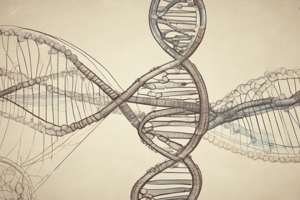Podcast
Questions and Answers
What is physiology primarily concerned with?
What is physiology primarily concerned with?
- The structure of living organisms
- The study of genetic variations
- The maintenance of homeostasis (correct)
- The evolutionary changes in organisms
How are genetics, anatomy, and physiology interconnected?
How are genetics, anatomy, and physiology interconnected?
- Anatomy provides insights into genetic variations
- Physiology studies the genetic basis of organisms
- Genetics examines the functions of anatomical structures
- Genetics provides the foundation for the structure and function of organisms (correct)
What technique in genetics can provide insights into associations of single nucleotide variants (SNVs) with traits and diseases?
What technique in genetics can provide insights into associations of single nucleotide variants (SNVs) with traits and diseases?
- Exome sequencing (correct)
- Electrophoresis
- Polymerase chain reaction (PCR)
- Chromatography
Why is studying the structure of the heart in anatomy valuable for understanding its function?
Why is studying the structure of the heart in anatomy valuable for understanding its function?
How have advancements in genetics, like exome sequencing, impacted the study of anatomy and physiology?
How have advancements in genetics, like exome sequencing, impacted the study of anatomy and physiology?
Flashcards are hidden until you start studying
Study Notes
Biology: Exploring the Interconnected Worlds of Genetics, Anatomy, and Physiology
Biology is a vast field of study concerned with living organisms and their interactions with the environment. It is divided into various subdisciplines, including genetics, anatomy, and physiology. These three areas are interconnected, as genetics provides the foundation for the structure and function of organisms, while anatomy and physiology study the structural organization and functional processes of living organisms.
Genetics
Genetics is the study of heredity, the passing of traits from parents to their offspring, and the mechanisms that control this process. The genetic material, DNA, is present in every cell of an organism and carries the instructions for its development, growth, reproduction, and other vital processes.
Anatomy to Genomics (ATG) is an educational initiative launched by Temple University School of Medicine that integrates exome sequencing data from cadavers used for anatomy instruction into the first-year curriculum. This program exposes students to the potential medical applications of next-generation sequencing and provides a self-directed learning experience focused on genetics.
Anatomy
Anatomy is the study of the structure of tissues, organs, and organ systems in living organisms. It is divided into macroscopic anatomy, which focuses on the large structures of the body, and microscopic anatomy, which examines the structures of cells and tissues.
In the realm of anatomy, researchers at the University of Notre Dame explore topics such as adaptations to subzero temperatures, circadian control of metabolism, neuroendocrinology, evolution and pathobiology of the mammalian skull, and reproductive biology.
Physiology
Physiology is the study of how the structures of living organisms function. It is concerned with the processes that maintain homeostasis, the balance of internal conditions necessary for life, and how these processes are regulated.
Physiology is closely related to anatomy, as it examines the functions of the structures studied in anatomy. For example, studying the structure of the heart in anatomy provides valuable information for understanding the physiological processes involved in the heart's function.
Interconnected Worlds
Genetics, anatomy, and physiology are interconnected, as genetics provides the foundation for the structure and function of organisms, while anatomy and physiology study the structural organization and functional processes of living organisms.
For instance, anatomy and physiology are essential for understanding the impact of genetic variations on an organism's structure and function. Exome sequencing, a technique used in genetics, can provide insights into the associations of single nucleotide variants (SNVs) with traits and diseases, as well as how these variants may have impacted the cadaver's health and subsequent healthcare.
Moreover, advancements in genetics, such as exome sequencing, have improved our ability to ascribe genetic risk to particular genes, which in turn has improved the sensitivity of methods used to study anatomy and physiology.
In conclusion, genetics, anatomy, and physiology are interconnected fields that provide a comprehensive understanding of living organisms. Together, they allow us to explore the complex relationships between an organism's structure, function, and the genetic basis for these traits.
Studying That Suits You
Use AI to generate personalized quizzes and flashcards to suit your learning preferences.




